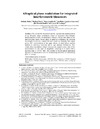Identificador persistente para citar o vincular este elemento:
https://accedacris.ulpgc.es/jspui/handle/10553/75831
| Campo DC | Valor | idioma |
|---|---|---|
| dc.contributor.author | Dante, Stefania | en_US |
| dc.contributor.author | Duval, Daphné | en_US |
| dc.contributor.author | Sepúlveda, Borja | en_US |
| dc.contributor.author | González-Guerrero, Ana Belen | en_US |
| dc.contributor.author | Sendra, José Ramón | en_US |
| dc.contributor.author | Lechuga, Laura M. | en_US |
| dc.date.accessioned | 2020-11-23T12:32:05Z | - |
| dc.date.available | 2020-11-23T12:32:05Z | - |
| dc.date.issued | 2012 | en_US |
| dc.identifier.other | Scopus | - |
| dc.identifier.uri | https://accedacris.ulpgc.es/handle/10553/75831 | - |
| dc.description.abstract | We present the theoretical and the experimental implementation of an all-optical phase modulation system in integrated Mach-Zehnder Interferometers to solve the drawbacks related to the periodic nature of the interferometric signal. Sensor phase is tuned by modulating the emission wavelength of low-cost commercial laser diodes by changing their output power. FFT deconvolution of the signal allows for direct phase readout, immune to sensitivity variations and to light intensity fluctuations. This simple phase modulation scheme increases the signal-to-noise ratio of the measurements in one order of magnitude, rendering in a sensor with a detection limit of 1.9·10-7 RIU. The viability of the all-optical modulation approach is demonstrated with an immunoassay detection as a biosensing proof of concept. | en_US |
| dc.language | eng | en_US |
| dc.relation.ispartof | Optics Express | en_US |
| dc.source | Optics Express[EISSN 1094-4087],v. 20 (7), p. 7195-7205, (Marzo 2012) | en_US |
| dc.subject | 3307 Tecnología electrónica | en_US |
| dc.subject.other | Optical sensors | en_US |
| dc.subject.other | Phase modulation | en_US |
| dc.subject.other | Interferometry | en_US |
| dc.subject.other | Biological sensing | en_US |
| dc.title | All-optical phase modulation for integrated interferometric biosensors | en_US |
| dc.type | info:eu-repo/semantics/Article | en_US |
| dc.type | Article | en_US |
| dc.identifier.doi | 10.1364/OE.20.007195 | en_US |
| dc.identifier.scopus | 84859402960 | - |
| dc.contributor.authorscopusid | 49561083500 | - |
| dc.contributor.authorscopusid | 24334830800 | - |
| dc.contributor.authorscopusid | 56036107700 | - |
| dc.contributor.authorscopusid | 56036163500 | - |
| dc.contributor.authorscopusid | 56036259400 | - |
| dc.contributor.authorscopusid | 6603774181 | - |
| dc.identifier.eissn | 1094-4087 | - |
| dc.description.lastpage | 7205 | en_US |
| dc.identifier.issue | 7 | - |
| dc.description.firstpage | 7195 | en_US |
| dc.relation.volume | 20 | en_US |
| dc.investigacion | Ingeniería y Arquitectura | en_US |
| dc.type2 | Artículo | en_US |
| dc.utils.revision | Sí | en_US |
| dc.date.coverdate | Marzo 2012 | en_US |
| dc.identifier.ulpgc | Sí | en_US |
| dc.contributor.buulpgc | BU-TEL | en_US |
| dc.description.sjr | 2,587 | |
| dc.description.jcr | 3,546 | |
| dc.description.sjrq | Q1 | |
| dc.description.jcrq | Q1 | |
| dc.description.scie | SCIE | |
| item.fulltext | Con texto completo | - |
| item.grantfulltext | open | - |
| crisitem.author.dept | Departamento de Ingeniería Electrónica y Automática | - |
| crisitem.author.orcid | 0000-0001-5385-792X | - |
| crisitem.author.fullName | Sendra Sendra, José Ramón | - |
| Colección: | Artículos | |
Citas SCOPUSTM
92
actualizado el 08-jun-2025
Citas de WEB OF SCIENCETM
Citations
79
actualizado el 08-jun-2025
Visitas
115
actualizado el 18-feb-2024
Descargas
185
actualizado el 18-feb-2024
Google ScholarTM
Verifica
Altmetric
Comparte
Exporta metadatos
Los elementos en ULPGC accedaCRIS están protegidos por derechos de autor con todos los derechos reservados, a menos que se indique lo contrario.
